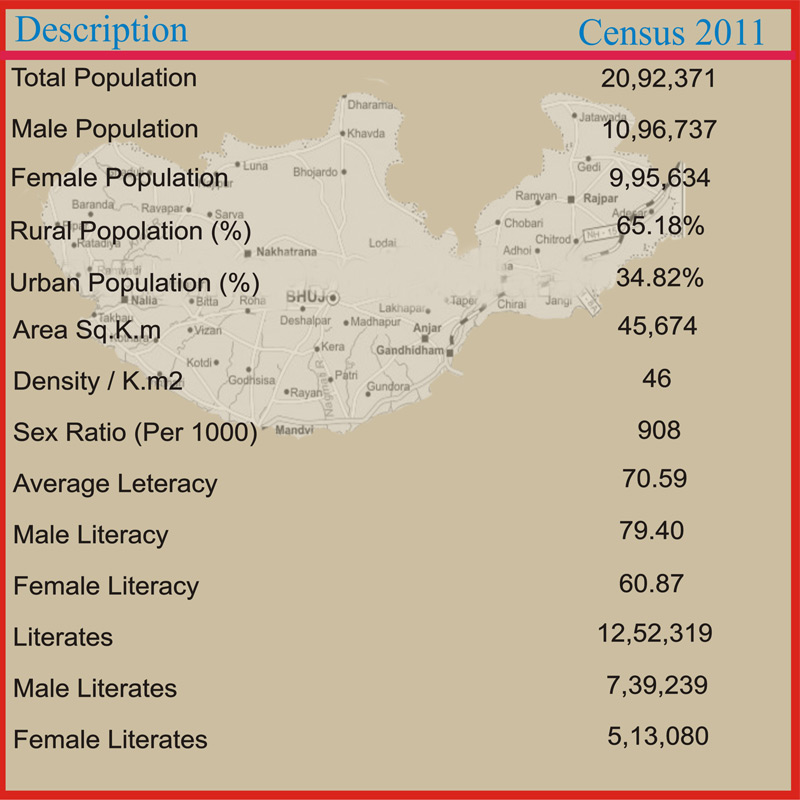
The word 'Kutch' inspires a sense of desert even though the characteristic attribute of area Great Rann and Little Rann in the minds of the people. Therefore, it is appropriately said that "Desert is in Kutch but Kutch is not a desert." The word ‘Kutch’ is initiated from its similarity to tortoise (Kachbo), its geographical figure. Bhuj is the capital town of Kutch.
The district Kutch is situated in the extreme west of India between 22' 44' 8' and 24' 41' 30' north latitude and 68' 7' 23' and 71' 46' 45' east longitude. It is surrounded in south by the Gulf of Kutch, in west by the Indian Ocean, in the north-east and south-east by the districts of Banaskantha and Mehsana. The Gulf of Kutch is separated from Kathiawar Peninsula. Kutch is also separated from Pakistan by the Great Rann of Kutch.
Area
The total area of Kutch is approximate 45,652 Sq.Kms. These figures make Kutch the biggest district in the state of Gujarat. Kutch is also the second largest district in India. Kutch is divided into ten Talukas: Bhuj, Anjar, Gandhidham, Nakhatrana, Lakhpat, Mandvi, Mundra, Bhachau, Rapar and Abdasa. There are about 951 villages and 10 talukas in Kutch.
Weather
The weather of Kutch is normally hot with a maximum temperature of 45° C during summer and a minimum temperature of 2° C during winter. The average rainfall of Kutch is 474 mm. June is the hottest month and December is the coolest month of Kutch. August has the maximum rainfall among all months in Kutch.
In the desert of Kutch, camels are the main sources of transportation. Camel is also called the ship of the desert. Kutch district has one major port Kandla and there are also three minor ports: Mandvi, Mundra and Jakhau. Kutch provides a propagation place for flamingos’ abroading from Europe and Africa in November-December.
There are two main agricultural communities Ahirs and Kanbis in Kutch. Communities like Jat, Mutwa, Node, Korar, Sameja, Sama, Sumra, Raishipotra, Halepotra and Bambha are active in cattle breeding in Banni. Lohana, Rajput, Brahmin, Jain, Soni etc. are the other communities of Kutch.
Kutchi people are kind-hearted. Diwali, Janmastami, Navratri, Ramjan Idd, Holi etc. are the important festivals of Kutch. Koteshwar, Bhadreshwar, Narayan Sarover, Jesal Toral, Swaminarayan Temple etc. are the holy places of Kutch. Ashapura, Ambaji, Rahucharaji, Hingalaj etc. are the mother Goddesses worshipped in Kutch.
Kutch is the home of the last remaining population of Khur (Asiatic Wild Ass) in India. There is also a large population of the birds like flamingos.
Population
In 2011, Kachchh had population of 2,092,371 of which male and female were 1,096,737 and 995,634 respectively. In 2001 census, Kachchh had a population of 1,583,225 of which males were 815,152 and remaining 768,073 were females. Kachchh District population constituted 3.46 percent of total Maharashtra population. In 2001 census, this figure for Kachchh District was at 3.12 percent of Maharashtra population.
In Kutch district, a semi-arid region, Maldharis or pastoral people constitute a considerable portion of the district population and the livelihood mainly depends on livestock rearing and agriculture. The scarcity of rain affects the means of livelihood viz., the rain-fed agriculture and animal husbandry. The climatic fluctuations coupled with natural calamities like drought, cyclone and so on make life dangerously vulnerable in the region. The earthquake of January 26, 2001, devastated the region in such a way that the plight of the people shocked the conscience of the world and philanthropic aid flowed to the region in an unprecedented way. The earthquake reportedly killed 30,000 people and adversely affected nearly one million.
A hostile natural atmosphere reduces the productivity of the land and decreases the livestock, thus the livelihood of the people is put in peril. Because of this they get into various types of debt trap that creates undue tensions for these small farmers.
Besides, the salinity of the water due to the proximity of the sea makes Kutch a flourishing land for groundwater exploitation by major companies which benefit the large land holders and makes them richer and richer while the small farmers become deprived of even the potable water they have. This leads them to a situation of drinking water scarcity in a big way.

